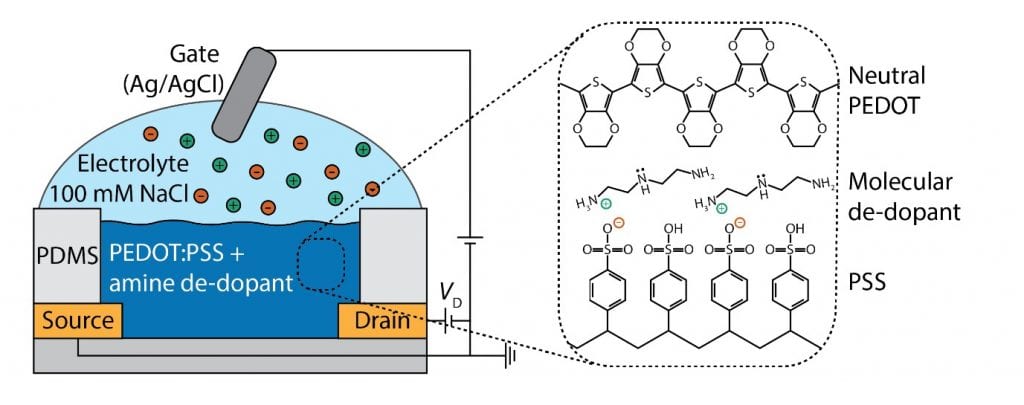Organic electrochemical transistors (OECTs) are widely considered promising devices for biological interfacing electronics or “bioelectronics”, with applications in flexible biosensors, electrophysiological recording electrodes, cell monitoring, and neuromorphic computing. They bridge the gap between aqueous solutions (found in biological systems) and electronics, using flexible materials which have similar mechanical properties to human tissue with exceptional biocompatibility.
The current material of choice for most OECTs is the commercially available conductive polymer PEDOT:PSS, used due to its high amplification factor (or transconductance, which reflects how much current a transistor can produce with the application of input voltage across its gate) and ease of processing. However, the material generally displays what is called depletion-mode operation, meaning the device is “ON” even when 0 V are applied to it. This is problematic as when the device is “ON”, electrical currents run freely, increasing the power consumption when used in a bioelectronic device.
The current leading solution to achieving enhancement-mode operation in which the system can attain an “OF” state has been to either chemically design new semiconducting polymers for OECTs or to chemically modify existing PEDOT-based materials. Synthesis of novel materials is a great approach to obtain high-performance, enhancement-mode OECTs, but because of the small-scale nature of this field of research it suffers from batch-to-batch variation and, additionally, commercialization and up-scaling are still a long way away. Thus, for external researchers to use these materials in their own OECT development, they must either try to perform the synthesis themselves or request the desired material from the original creators, which limits access.
Chemically modifying PEDOT polymer variants has had some success in making enhancement-mode OECTs, but the performance has been substantially lower (about 100 times) than depletion-mode PEDOT:PSS OECTs, thus limiting the impact of such techniques. It is critical that enhancement-mode OECTs have similar performance to their depletion-mode counterparts to be relevant for bioelectronic applications.
Now, in a recent article published in the journal Advanced Materials, Professor Yoeri van de Burgt from the Eindhoven University of Technology, the Netherlands, and Professor Alberto Salleo from Standford University address the problem of making high-performance OECTs which operate in enhancement-mode, leading to biosensors and biocompatible electronic circuits that require less power to operate compared to conventional devices.

By designing innovative ways to modify the material properties of PEDOT:PSS — and therefore the properties of the OECT device itself — the team of researchers provides additional building blocks to design complex and optimized bioelectronic systems based on a straightforward fabrication technique that uses commercially available materials.
The team outlines that further optimization of these materials with respect to their application is still required to make them commercially viable. This involves tuning and controlling their structure and morphology to adapt them to a specific functionality, such as charge transport, sensitivity, or long-term stability.
“It is great to see that some challenging problems can still be solved by straightforward solutions, which in this case involves only the addition of other commercially available materials”, concluded van de Burgt.
Reference: S.T. Keene, et al. ‘Enhancement‐Mode PEDOT:PSS Organic Electrochemical Transistors Using Molecular De‐Doping.’ Advanced Materials (2020). DOI: 10.1002/adma.202000270

















